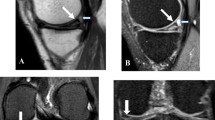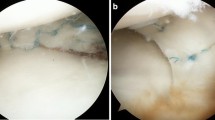Abstract
Purpose
At our institution, fast spin-echo (FSE) proton density (PD) imaging is used to evaluate articular cartilage, while conventional spin-echo (CSE) T1-weighted sequences have been traditionally used to characterize meniscal pathology. We sought to determine if FSE PD-weighted sequences are equivalent to CSE T1-weighted sequences in the detection of meniscal tears, obviating the need to perform both sequences.
Method and materials
We retrospectively reviewed the records of knee arthroscopies performed by two arthroscopy-focused surgeons from an academic medical center over a 2-year period. The preoperative MRI images were interpreted independently by two fellowship-trained musculoskeletal radiologists who graded the sagittal CSE T1 and FSE PD sequences at different sittings with grades 1–5, where 1 = normal meniscus, 2 = probable normal meniscus, 3 = indeterminate, 4 = probable torn meniscus, and 5 = torn meniscus. Each meniscus was divided into an anterior and posterior half, and these halves were graded separately. Operative findings provided the gold standard. Receiver operating characteristic (ROC) analysis was performed to compare the two sequences.
Results
There were 131 tears in 504 meniscal halves. Using ROC analysis, the reader 1 area under curve for FSE PD was significantly better than CSE T1 (0.939 vs. 0.902, >95% confidence). For reader 2, the difference met good criteria for statistical non-inferiority but not superiority (0.913 for FSE PD and 0.908 for CSE T1; >95% non-inferiority for difference at most of −0.027).
Conclusion
FSE PD-weighted sequences, using our institutional protocol, are not inferior to CSE T1-weighted sequences for the detection of meniscal tears and may be superior.






Similar content being viewed by others
References
Fu FH, Harner CD, Vince KG. Knee surgery. Baltimore, MD: Williams & Wilkins; 1994.
Rubin DA, Paletta GA Jr. Current concepts and controversies in meniscal imaging. Magn Reson Imaging Clin N Am 2000; 8: 243–270.
Mackenzie R, Dixon AK, Keene GS, Hollingworth W, Lomas DJ, Villar RN. Magnetic resonance imaging of the knee: assessment of effectiveness. Clin Radiol 1996; 51: 245–250.
Bui-Mansfield LT, Youngberg RA, Warme W, Pitcher JD, Nguyen PL. Potential cost savings of MR imaging obtained before arthroscopy of the knee: evaluation of 50 consecutive patients. AJR Am J Roentgenol 1997; 168: 913–918.
Carmichael IW, MacLeod AM, Travlos J. MRI can prevent unnecessary arthroscopy. J Bone Joint Surg Br 1997; 79: 624–625.
Ruwe PA, Wright J, Randall RL, Lynch JK, Jokl P, McCarthy S. Can MR imaging effectively replace diagnostic arthroscopy? Radiology 1992; 183: 335–339.
Reicher MA, Hartzman S, Duckwiler GR, Bassett LW, Anderson LJ, Gold RH. Meniscal injuries: detection using MR imaging. Radiology 1986; 159: 753–757.
Kojima KY, Demlow TA, Szumowski J, Quinn SF. Coronal fat suppression fast spin echo images of the knee: evaluation of 202 patients with arthroscopic correlation. Magn Reson Imaging 1996; 14: 1017–1022.
De Smet AA, Graf BK. Meniscal tears missed on MR imaging: relationship to meniscal tear patterns and anterior cruciate ligament tears. AJR Am J Roentgenol 1994; 162: 905–911.
Blackmon GB, Major NM, Helms CA. Comparison of fast spin-echo versus conventional spin-echo MRI for evaluating meniscal tears. AJR Am J Roentgenol 2005; 184: 1740–1743.
Cheung LP, Li KC, Hollett MD, Bergman AG, Herfkens RJ. Meniscal tears of the knee: accuracy of detection with fast spin-echo MR imaging and arthroscopic correlation in 293 patients. Radiology 1997; 203: 508–512.
Crues JV 3rd, Mink J, Levy TL, Lotysch M, Stoller DW. Meniscal tears of the knee: accuracy of MR imaging. Radiology 1987; 164: 445–448.
Fischer SP, Fox JM, Del Pizzo W, Friedman MJ, Snyder SJ, Ferkel RD. Accuracy of diagnoses from magnetic resonance imaging of the knee. A multi-center analysis of one thousand and fourteen patients. J Bone Joint Surg Am 1991; 73: 2–10.
Kowalchuk RM, Kneeland JB, Dalinka MK, Siegelman ES, Dockery WD. MRI of the knee: value of short echo time fast spin-echo using high performance gradients versus conventional spin-echo imaging for the detection of meniscal tears. Skeletal Radiol 2000; 29: 520–524.
Rubin DA, Kettering JM, Towers JD, Britton CA. MR imaging of knees having isolated and combined ligament injuries. AJR Am J Roentgenol 1998; 170: 1207–1213.
Justice WW, Quinn SF. Error patterns in the MR imaging evaluation of menisci of the knee. Radiology 1995; 196: 617–621.
Bredella MA, Tirman PF, Peterfy CG, et al. Accuracy of T2-weighted fast spin-echo MR imaging with fat saturation in detecting cartilage defects in the knee: comparison with arthroscopy in 130 patients. AJR Am J Roentgenol 1999; 172: 1073–1080.
Broderick LS, Turner DA, Renfrew DL, Schnitzer TJ, Huff JP, Harris C. Severity of articular cartilage abnormality in patients with osteoarthritis: evaluation with fast spin-echo MR vs arthroscopy. AJR Am J Roentgenol 1994; 162: 99–103.
Potter HG, Linklater JM, Allen AA, Hannafin JA, Haas SB. Magnetic resonance imaging of articular cartilage in the knee. An evaluation with use of fast-spin-echo imaging. J Bone Joint Surg Am 1998; 80: 1276–1284.
Anderson MW, Raghavan N, Seidenwurm DJ, Greenspan A, Drake C. Evaluation of meniscal tears: fast spin-echo versus conventional spin-echo magnetic resonance imaging. Acad Radiol 1995; 2: 209–214.
Escobedo EM, Hunter JC, Zink-Brody GC, Wilson AJ, Harrison SD, Fisher DJ. Usefulness of turbo spin-echo MR imaging in the evaluation of meniscal tears: comparison with a conventional spin-echo sequence. AJR Am J Roentgenol 1996; 167: 1223–1227.
Metz CE, Herman BA, Roe CA. Statistical comparison of two ROC-curve estimates obtained from partially-paired datasets. Med Decis Making 1998; 18: 110–121.
Dorfman DD, Berbaum KS, Metz CE. Receiver operating characteristic rating analysis. Generalization to the population of readers and patients with the jackknife method. Invest Radiol 1992; 27: 723–731.
Hillis SL, Berbaum KS. Monte Carlo validation of the Dorfman–Berbaum–Metz method using normalized pseudovalues and less data-based model simplification. Acad Radiol 2005; 12: 1534–1541.
Pesce LL, Metz CE. Reliable and computationally efficient maximum-likelihood estimation of “proper” binormal ROC curves. Acad Radiol 2007; 14: 814–829.
Pepe MS. The statistical evaluation of medical tests for classification and prediction. New York: Oxford University Press; 2004.
Rubin DA, Kneeland JB, Listerud J, Underberg-Davis SJ, Dalinka MK. MR diagnosis of meniscal tears of the knee: value of fast spin-echo vs conventional spin-echo pulse sequences. AJR Am J Roentgenol 1994; 162: 1131–1135.
Iinuma G, Ushio K, Ishikawa T, Nawano S, Sekiguchi R, Satake M. Diagnosis of gastric cancers: comparison of conventional radiography and digital radiography with a 4 million-pixel charge-coupled device. Radiology 2000; 214: 497–502.
Park SH, Goo JM, Jo CH. Receiver operating characteristic (ROC) curve: practical review for radiologists. Korean J Radiol 2004; 5: 11–18.
Obuchowski NA. Receiver operating characteristic curves and their use in radiology. Radiology 2003; 229: 3–8.
Mushlin AI, Detsky AS, Phelps CE, et al. The accuracy of magnetic resonance imaging in patients with suspected multiple sclerosis. The Rochester–Toronto Magnetic Resonance Imaging Study Group. JAMA 1993; 269: 3146–3151.
Wagner RF, Beiden SV, Campbell G, Metz CE, Sacks WM. Assessment of medical imaging and computer-assist systems: lessons from recent experience. Acad Radiol 2002; 9: 1264–1277.
Peh WCG, Chan JHM, Shek TWH, Wond JWK. The effect of using shorter echo times in MR imaging of knee menisci: a study using a porcine model. AJR 1999; 172: 485–488.
Quinn SF, Brown TR, Szumowski J. Menisci of the knee: radial MR imaging correlated with arthroscopy in 259 patients. Radiology 1992; 185: 577–580.
De Smet AA, Tuite MJ. Use of the “two-slice-touch” rule for the MRI diagnosis of meniscal tears. AJR Am J Roentgenol 2006; 187: 911–914.
Quinn SF, Brown TF. Meniscal tears diagnosed with MR imaging versus arthroscopy: how reliable a standard is arthroscopy? Radiology 1991; 181: 843–847.
Author information
Authors and Affiliations
Corresponding author
Additional information
This manuscript has not been presented or accepted for presentation at any meeting or in any journal.
Rights and permissions
About this article
Cite this article
Wolff, A.B., Pesce, L.L., Wu, J.S. et al. Comparison of spin echo T1-weighted sequences versus fast spin-echo proton density-weighted sequences for evaluation of meniscal tears at 1.5 T. Skeletal Radiol 38, 21–29 (2009). https://doi.org/10.1007/s00256-008-0561-1
Received:
Revised:
Accepted:
Published:
Issue Date:
DOI: https://doi.org/10.1007/s00256-008-0561-1




